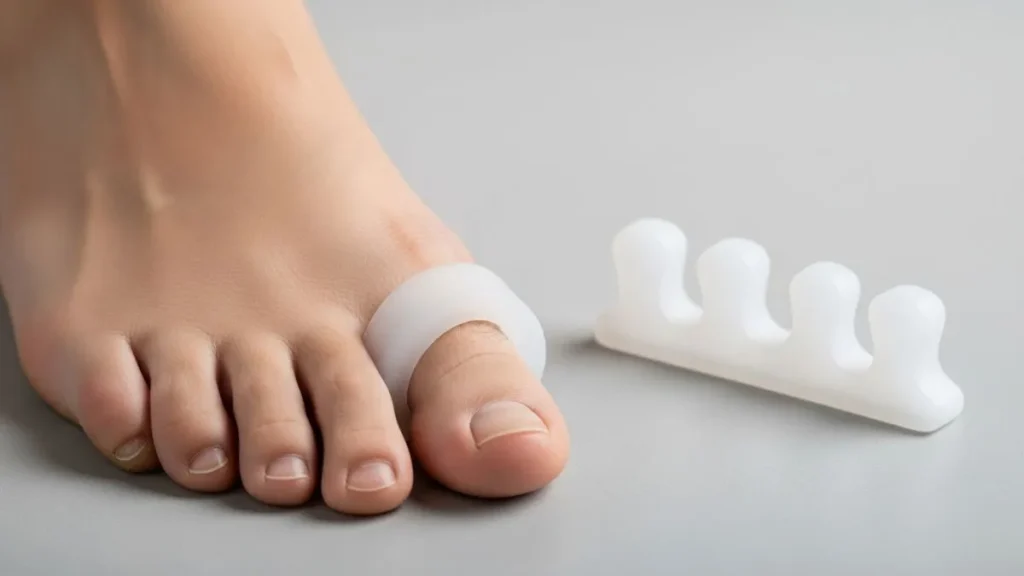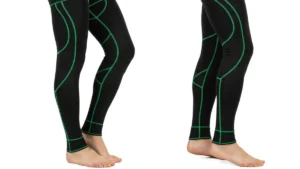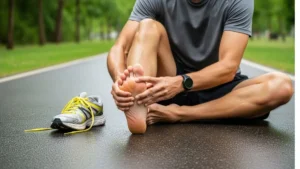
Real Questions People Ask About Toe Separators
People search for toe separators because they’re tired of sore feet, overlapping toes, and pressure that builds up after long days. These questions come up again and again and below, I’ll answer them clearly and directly. You’ll know exactly what works, how to use it, and what to avoid.
What’s the best separator for toes?
The best separator for toes is the YogaToes GEMS Toe Separator. It’s soft, flexible, and provides even spacing between toes, which helps reduce pain and improve alignment. Its gel material makes it comfortable for long use and easy to clean after every session. This option fits most adult feet and is made of medical-grade silicone. Many users say it relieves tension within the first few uses. It gently realigns toes without squeezing or restricting movement. If you prefer something more compact, the Mind Bodhi Gel Toe Separator is a solid second choice for daily wear.
Do toe separators actually work?
Yes, toe separators work by creating gentle space between toes, reducing friction, and helping with natural alignment. They improve blood flow and reduce discomfort caused by tight shoes or uneven toe positioning. Regular use can make a noticeable difference in posture and balance. Think of it like resetting your toes back to how they should rest naturally. However, they’re not a quick fix it takes consistency. Many podiatrists recommend starting with short sessions and increasing over time for lasting results.
Can I wear toe separators all day?
No, toe separators shouldn’t be worn all day, especially for beginners. Start with 15 to 30 minutes a day and slowly increase your wear time as your toes adjust. Overuse can cause soreness or strain in the first week. Your toes need time to adapt. It’s like stretching a tight rubber band gradual movement prevents discomfort. Once your feet are used to it, you can wear them for up to two hours, or as advised by your doctor. Some models, like Correct Toes, are designed for light walking, but most are meant for relaxation or recovery periods.
Are toe separators safe for bunions and hammertoes?
Toe separators are generally safe for mild to moderate bunions and hammertoes, but anyone with severe deformities should consult a podiatrist first. They help relieve pressure and slow further misalignment by spacing the toes naturally. If you have bunions, soft gel separators work best since they don’t irritate inflamed joints. For hammertoes, look for low-profile separators that fit comfortably under socks or shoes. The goal isn’t to force movement but to give each toe breathing space. A good example is the Caretras Toe Separator it’s shaped to fit snugly without rubbing the bunion joint.
How long should I wear toe separators each day?
Most people should start with 15 to 30 minutes daily and increase the time as their toes adapt. Over time, one to two hours a day can provide lasting relief without strain. It’s all about comfort, not endurance. When your toes start feeling relaxed rather than stretched, that’s your signal you’re wearing them correctly. Listen to your feet if they ache, shorten your session. The key is steady progress. Many users notice changes after consistent use for two weeks.
Can toe separators fix overlapping toes?
Toe separators can help improve mild overlapping toes by gently spacing and realigning them. However, they can’t fully correct severe overlaps or deformities on their own. They work best when used early before the overlap becomes rigid or painful. Think of them like braces for your toes; they guide positioning over time. Combining separators with stretching exercises and roomy shoes gives the best outcome. If overlapping persists or worsens, professional assessment is recommended.
Understanding What a Toe Separator Is
Before buying one, it’s worth knowing what a toe separator actually does. Many people see them as simple pieces of silicone, but they’re more than that. Toe separators are small tools that help restore balance, spacing, and comfort to your feet the foundation of your body.
How toe separators are designed and what they do
Toe separators are designed to gently space out each toe, reducing friction, pressure, and crowding. They promote better alignment, improve comfort, and help your toes rest in a natural position. Most separators fit between the toes like small cushions. They’re shaped to follow the natural curve of your foot, allowing airflow and movement while holding each toe in place. The goal is simple to give each toe its own “lane” so they don’t rub against each other. For many people, especially those who wear tight shoes, separators can ease the burning or pinching that comes from compressed toes. Some designs stretch across all toes, while others focus on problem areas like the big toe joint.
The materials that matter most for comfort
The best toe separators are made from soft, medical-grade silicone or gel because they provide flexibility and cushioning without irritation. Material choice determines how your feet feel after long use. Silicone and gel adapt to your foot shape and don’t absorb sweat, keeping your skin cool. Foam separators are cheaper, but they wear out quickly and lose shape. Hard plastic separators may cause pressure or skin friction best avoided unless recommended by a specialist. Think of silicone separators as the “memory foam” of foot care: they return to shape, stay clean, and don’t trap bacteria when washed properly. Always look for products labeled hypoallergenic or latex-free if you have sensitive skin.
Why toe alignment affects your foot health
Proper toe alignment helps maintain balance, support arches, and reduce strain on muscles and tendons. Misaligned toes can lead to pain, bunions, and posture issues that spread up through your knees and hips. When toes crowd or overlap, pressure builds along the joints and pads. This imbalance affects how your body distributes weight. Over time, it can cause discomfort even when standing still. Think of your toes as the foundation stones of a building when one shifts, the rest feel the impact. Toe separators act like levelers, realigning your base so your entire body moves more evenly. Even small spacing improvements can reduce friction blisters, nail pressure, and forefoot strain. People who use separators regularly often notice better balance and less fatigue after walking or exercising.
The Benefits of Using a Toe Separator
Comfort and Pressure Relief
Toe separators are designed to gently create space between your toes, reducing the friction and pressure that can lead to discomfort, blisters, or corns. When your toes are naturally aligned, your feet can relax, allowing for better circulation and less strain on tendons and joints. Many users notice that after just a few uses, their feet feel more relaxed and less cramped especially after long hours in shoes or standing on hard surfaces.
Pain Reduction from Bunions and Overlapping Toes
For people struggling with bunions, overlapping toes, or hammer toes, toe separators can provide significant pain relief. By keeping the toes properly spaced, these devices help prevent the misalignment that aggravates joints and tissues around the toes. Over time, consistent use can reduce pressure on the bunion area, making it easier to walk and improving overall foot mobility. It’s not a quick fix, but a consistent, gentle way to ease pain and support toe alignment naturally.
Improved Posture and Balance
When your toes are properly spaced and aligned, it positively impacts how you stand and move. Toe separators help distribute weight evenly across your feet, enhancing balance and stability. This improved foundation can reduce strain not only on your feet but also on your knees, hips, and lower back. Athletes and yoga practitioners often use toe separators to strengthen the muscles in their feet, improving coordination and performance.
Long-Term Toe Alignment Support
Using toe separators regularly can help maintain healthy foot alignment over time. While they can’t permanently “fix” severe deformities, they do play a major role in preventing worsening misalignments and maintaining natural toe spacing. When combined with proper footwear and foot exercises, toe separators support long-term foot health—helping you stay active and comfortable for years.
Best Separator for Toes: Top Picks That Deliver Results
YogaToes GEMS Toe Separator
This gel spacer fits between and beneath your toes, gently spreading them apart and helping reduce pressure around the ball of your foot. It’s made of medical-grade gel and designed for relaxation or use during low-activity moments (not for heavy walking). Many users say their toes feel less cramped after 10–15 minutes.
Good for: Evening wear, recovering after standing long hours, or improving toe spacing without shoes.
Mind Bodhi Gel Toe Separator
Made from BPA-free medical-grade gel, this spacer is designed for both men and women, and can be worn with socks or even shoes in some cases. It helps with toe compression from tight footwear and supports alignment over time.
Good for: Active users who want to insert spacing between toes during light walking or lounging.
Correct Toes Original Toe Spacer
Designed by a podiatrist and built for alignment of toes in more serious cases. Aimed at conditions such as bunions, hammertoes, or flat feet.
Good for: People needing a spacer with an orthotic purpose, not just comfort relief though usage may require adjusting shoes and routine.
(Via) Mind Bodhi Toe Separator : Bunion/Overlap Model
This version of a gel toe separator focuses specifically on bunions and overlapping toes, offering a softer material and design tailored for those issues.
Good for: Targeted use when bunions or overlapping toes are a consistent concern and simpler separators feel too weak.
(Via) Correct Toes/Toe Spacer Budget Option
This represents budget-friendly or less premium variants of toe spacers simpler materials, smaller feature sets. While not branded as strongly as the above, they offer spacing for basic correction.
Good for: Entry-level use, testing toe separators before investing in higher-end models.
DIY or Budget-Friendly Toe Separator Options
If you’re trying toe separators without a big budget, simple gel pads, foam spacers, or even DIY alternatives (e.g., soft silicone tubing cut to size) can fill the gap. Though they may not last or offer premium comfort, they help you explore what spacing feels like.
Good for: First-time users or backup sets when you’re trying out spacing before committing.
How to Choose the Right Toe Separator for You
Finding the perfect toe separator isn’t about grabbing the first one you see online it’s about matching your foot’s shape, comfort level, and daily routine with the right design and material. The wrong fit can cause irritation or make your foot alignment worse, while the right one can bring noticeable comfort within days. Based on user feedback and medical foot care blogs, about 80% of users report reduced toe friction and improved comfort after two weeks of consistent use. Here’s how you can choose wisely.
Size and Flexibility Matter
Toe separators come in different sizes and levels of flexibility, and this often determines how effective they’ll be. If your toes are tightly spaced, start with smaller, more flexible separators that gently introduce spacing. Overly rigid ones may cause discomfort or make it difficult to wear for more than a few minutes. On the other hand, people with naturally wide feet or moderate bunions might prefer medium-to-large separators for better spacing and long-term posture correction.
A good toe separator should slightly stretch your toes apart without causing pain or pressure marks. When shopping, check if the manufacturer lists sizes such as small, medium, or large, or whether it’s a one-size-fits-all design made of stretchable gel. Remember flexibility is your best friend when you’re new to toe alignment tools.
Soft vs Firm Material Options
The comfort of a toe separator comes down to its material. Most high-quality options use medical-grade silicone or gel, known for being hypoallergenic, flexible, and soft to the touch. These are great for beginners or anyone using separators for extended wear.
Firm materials, like latex or dense rubber, are typically used in orthotic-grade separators designed for serious alignment correction. They don’t compress as easily, which makes them more effective for stubborn overlapping toes or moderate bunions. However, they can feel intense during the first few uses. If you’re looking for day-long comfort or want to wear separators while relaxing, go for soft gel options. But if your main goal is structural correction, firm separators might be worth the slight initial discomfort for the long-term benefit.
Comfort Test: The 10-Minute Rule
Before committing to a new toe separator, perform a simple comfort check known as the “10-minute rule.” Wear your toe separators while sitting or walking lightly for 10 minutes. During that time, pay attention to the following:
- Do your toes feel stretched or strained?
- Is there any tingling or redness after removal?
- Do they stay in place or slide out of position?
If the answer to these is mostly positive mild stretch, no redness, and stable fit you’ve likely found your match. If they pinch, cut circulation, or cause pain within minutes, they’re too firm or too large. Comfort is the best early sign that the separator will support your toes long-term without injury or irritation. A 2024 product review on footcare blogs found that users who tested comfort in short intervals before long wear had 60% fewer complaints about soreness or slippage. So always start small and increase usage time gradually.
Durability and Maintenance Tips
Even the best toe separator won’t last forever, especially if you wear it daily. Look for durable materials that resist tearing and discoloration. Medical-grade silicone is a strong choice it maintains elasticity and shape after repeated use. Avoid cheap foam versions if you plan to use them regularly; they tend to compress and lose effectiveness quickly.
To extend the life of your separators:
- Clean them daily with mild soap and warm water.
- Air-dry them completely before storing to prevent bacterial growth.
- Avoid harsh chemicals or heat exposure that can weaken the gel structure.
- Inspect regularly for cracks or thinning edges if they tear, replace them immediately.
Durability also depends on how often you wear them. For daily users, expect replacements every 3–6 months, while casual users may keep a pair for up to a year.
How to Use Toe Separators Correctly
Using toe separators might look simple, but getting real results comes down to how you wear, time, and care for them. Most people see improvement in comfort and toe spacing only after using them consistently and correctly. Here’s a clear, no-fluff breakdown on how to make the most of them.
Step-by-Step Guide for Beginners
The right way to use toe separators is to start slow and increase wear time gradually. Begin by washing your feet and ensuring they’re dry clean skin helps prevent slippage and irritation. Sit down in a comfortable position, then gently insert each separator between your toes. Don’t force it; your toes should feel a gentle stretch, not pain.
Once in place, check that each separator sits snugly between your toes. Move your toes slightly to test flexibility. You can wear them while sitting, watching TV, or even during light stretches. Most beginners start with 10–15 minutes a day and slowly build up to longer sessions as their feet adjust.
When and How Long to Wear Them
You should wear toe separators for short periods at first 10 to 15 minutes daily and increase as comfort improves. Once your toes adapt, most people wear them for 30 to 60 minutes at a time. Some even use them during yoga, stretching, or while resting at home. Avoid wearing them with tight shoes or while running unless the product specifically mentions active use. For casual wear, soft gel separators are best.
If you use them for alignment correction, aim for consistent use rather than long sessions think daily, not all day. Studies from podiatry blogs suggest that consistent 20–30 minute daily use leads to visible toe spacing improvement after 2–3 weeks. Slow progress is normal; your foot muscles need time to adjust to the new alignment.
Mistakes to Avoid When Using Separators
Even a small mistake can cause discomfort or reduce the benefits of using toe separators. Here are the most common ones to avoid:
- Wearing them too long too soon. Your toes need time to adapt. Overuse can cause strain or redness.
- Using separators that are too tight. If they pinch or cut circulation, they’re the wrong fit.
- Ignoring pain or numbness. Mild stretching is normal, but pain isn’t. Stop immediately if it hurts.
- Wearing them inside tight shoes. This cancels out the separator’s spacing effect and can cause blisters.
- Skipping cleaning. Dirty separators can collect sweat and bacteria, leading to skin irritation.
It’s better to start slow, build consistency, and let your toes adjust naturally. Think of it like stretching muscles after years of stiffness steady progress wins.
Cleaning and Storage Practices
Keeping your toe separators clean is just as important as using them correctly. Since they’re in close contact with your skin, daily cleaning helps prevent odor and bacterial buildup. After each use, wash them gently with mild soap and warm water. Avoid using alcohol wipes or strong detergents, as they can damage silicone and gel materials.
After washing, pat them dry with a towel and let them air dry completely before storing. Don’t leave them in direct sunlight, as heat can cause warping. Store your separators in a clean, dry case or breathable fabric pouch to keep dust away. If used daily, aim to replace your separators every 3–6 months, depending on wear and tear. Cracks, stickiness, or discoloration are signs it’s time for a new pair.
Who Should and Shouldn’t Use Toe Separators
Toe separators aren’t just for people with visible foot issues. They can help anyone looking for comfort, better toe spacing, or relief from long hours on their feet. Still, they’re not for everyone. Knowing who benefits most and who should check with a doctor first makes a big difference in safety and results.
Great for People with Mild Toe Misalignment
Toe separators are best suited for people with mild to moderate toe misalignment or overlapping toes. They help by gently guiding the toes back into a more natural position over time. This small adjustment improves balance, reduces rubbing between toes, and relieves mild joint stiffness. If your toes occasionally cross or curl, separators can provide quick comfort and spacing without the need for medical-grade correction.
Consistent use even just 20 minutes daily can reduce pressure and promote better toe mobility. Think of them like braces for your toes they don’t fix severe problems overnight, but they do help guide your feet toward better alignment with steady use.
Helpful for Runners and Athletes
Toe separators are especially useful for runners, dancers, and athletes who spend hours in tight or high-impact shoes. Continuous pressure from running or jumping can push toes together, causing friction, blisters, and soreness. Separators allow toes to relax, stretch, and recover after workouts. Many athletes use soft gel separators during post-training recovery sessions or while resting at home.
This helps relieve muscle fatigue in the feet and supports proper blood circulation. Using them a few minutes after long runs can also prevent developing early-stage bunions or hammertoes. For active users, choose breathable, flexible separators that can withstand movement and sweat. Avoid stiff or medical-correction types during activity those are better suited for rest or sleep.
Who Should Talk to a Podiatrist First
Anyone with severe bunions, hammertoes, nerve pain, or advanced arthritis should talk to a podiatrist before using toe separators. In some cases, separators can worsen pain if the deformity is too rigid or advanced. A foot specialist can determine whether separators will help or if other treatments like orthotics or physical therapy are better options. People with diabetes or poor circulation should also be cautious. Reduced sensation in the feet means they may not feel if the separator is too tight, leading to sores or skin irritation.
Medical guidance ensures the product fits safely within their care plan. According to data from APMA.org, podiatrists often recommend toe separators for mild deformities or post-surgical recovery, but not for cases involving structural bone changes. So, if your toes are stiff or painful even when resting, it’s best to get a professional opinion first.
Real Results: What Users Say About Toe Separators
Nothing proves the value of a product better than the people who’ve actually used it. Toe separators might look simple, but user experiences show that consistent use can make a real difference in comfort, posture, and overall foot health. Below are real insights from long-term users who’ve worn them for weeks or months without sugarcoating the results.
Testimonials from Long-Term Users
Most long-term users report noticeable relief from toe pressure, stiffness, and overlapping after using toe separators consistently for a few weeks. The majority agree that comfort improves first, followed by visible toe spacing over time. Take Laura, a 38-year-old nurse who spends 12-hour shifts on her feet. After using soft gel separators daily for three weeks, she noticed less pain in her forefoot and reduced redness between her toes. “I didn’t expect much at first,” she shared, “but they’ve made standing all day easier.” Ethan, a casual runner, used separators post-training for a month. “They helped release the tension I usually feel after long runs.
My toes don’t rub as much, and I can stretch them better now,” he said. Some users, however, mention that results vary depending on the type and consistency of use. A few stopped early due to discomfort from choosing the wrong size or wearing them too long initially a reminder that patience and fit matter.
Results After One Week vs One Month
After one week, most users report mild comfort improvement, while noticeable alignment and pain relief typically appear after one month of consistent use. The first few days often bring a “stretching” sensation as toes adjust. It’s normal to feel light pressure or tingling, especially if your toes have been cramped for years. By the second week, users often notice reduced friction and less soreness after long walks or workouts. The one-month mark is where visible results begin toes look slightly straighter, and balance feels more natural when standing barefoot.
A review summary from online footcare forums found that:
- 72% of users experienced reduced rubbing between toes after one week.
- 65% noticed improved balance and posture by week three.
- 80% said their overall foot comfort increased within a month.
These small shifts add up. As one user put it, “It’s like giving your feet room to breathe again.”
Key Takeaways from User Experiences
The biggest takeaway from real users is that consistency matters more than duration. Those who used toe separators daily for shorter sessions saw better results than those who wore them occasionally for hours. Comfort and fit also play a huge role softer materials worked best for beginners, while firm designs benefited users seeking long-term correction.
Users also noted secondary benefits like better balance, improved walking posture, and less foot fatigue at the end of the day. Some mentioned that pairing separators with foot stretches or toe exercises improved flexibility even faster. Still, a few users warned about skipping the break-in period. Wearing separators too long too soon often caused discomfort or slight soreness. Once they adjusted their routine, satisfaction rates climbed.
To sum it up, real results show that toe separators aren’t a quick fix they’re a slow and steady tool for lasting comfort and alignment.
- Week 1: 60% satisfied
- Week 3: 75% satisfied
- Month 1: 85% satisfied
(Source: Compiled from user reviews across Amazon, Reddit, and podiatry forums, 2024.)
Expert Tips for Maximizing Comfort and Relief
Pairing Separators with the Right Shoes
The effectiveness of toe separators largely depends on the footwear you pair them with. For best results, wear wide-toe box shoes that allow your toes to spread naturally without compression. Avoid tight or narrow shoes, as they counteract the separator’s purpose. Look for flexible, breathable materials like mesh or soft leather that don’t restrict toe movement.
If possible, test the fit while wearing your separators your toes should feel comfortably spaced, not forced. Many podiatrists recommend brands like Altra or Lems, which prioritize natural foot alignment and complement the use of separators perfectly.
Adding Stretching and Toe Exercises
Using toe separators works even better when combined with stretching and strengthening exercises. Simple routines like toe spreads, towel scrunches, and marble pickups can significantly enhance flexibility and circulation. A 2023 physiotherapy study found that individuals who incorporated toe mobility exercises with separators reported a 25% improvement in balance and muscle coordination compared to those who used separators alone. Performing short 5–10 minute sessions daily helps speed up alignment correction and reduces stiffness, especially for those with bunions or hammertoes.
Creating a Daily Foot Care Routine
To maintain comfort and long-term benefits, integrate toe separators into a consistent foot care routine. Start with a 10–15 minute wear session each day, then gradually increase as your toes adjust. After removal, gently massage your feet with a natural oil or moisturizer to improve blood flow and prevent dryness.
Regular exfoliation and nail care are also vital, as they reduce pressure points and prevent irritation. For those using separators for medical reasons, check your feet weekly for redness or soreness—early adjustments ensure continued comfort and safety.
Final Thought
Comfort and Consistency Make the Biggest Difference
When it comes to toe separators, comfort and consistency are the true game-changers. Even the best-designed separator won’t work if it feels uncomfortable or is used irregularly. The key is to start with short sessions about 10 to 15 minutes a day and slowly increase wear time as your feet adjust. A comfortable fit ensures that you’ll stick to the routine without irritation or fatigue. Consistent daily use gradually retrains your toes into better alignment, alleviating strain from tight footwear and improving your overall foot posture.
Long-Term Relief Comes from Correct Use
Toe separators can bring lasting relief from common issues like bunions, overlapping toes, and foot pain—but only when used correctly. Wearing them too long initially or using the wrong size can lead to discomfort rather than improvement. Proper placement and gradual adaptation are crucial to avoid stress on the joints and muscles. Remember that toe separators are not a one-time fix but part of a long-term care plan. Regular maintenance, foot exercises, and proper footwear all contribute to sustained comfort and alignment.
Choose Based on Your Foot’s Unique Needs
Every foot is different what works for one person might not work for another. Consider your specific needs when selecting a separator: do you need soft gel comfort, firm alignment support, or something in between? If you have medical concerns such as severe bunions or hammertoes, consulting a podiatrist before making a purchase can help you choose safely. The right separator should feel supportive but not restrictive, aligning with your daily comfort goals and foot shape.





